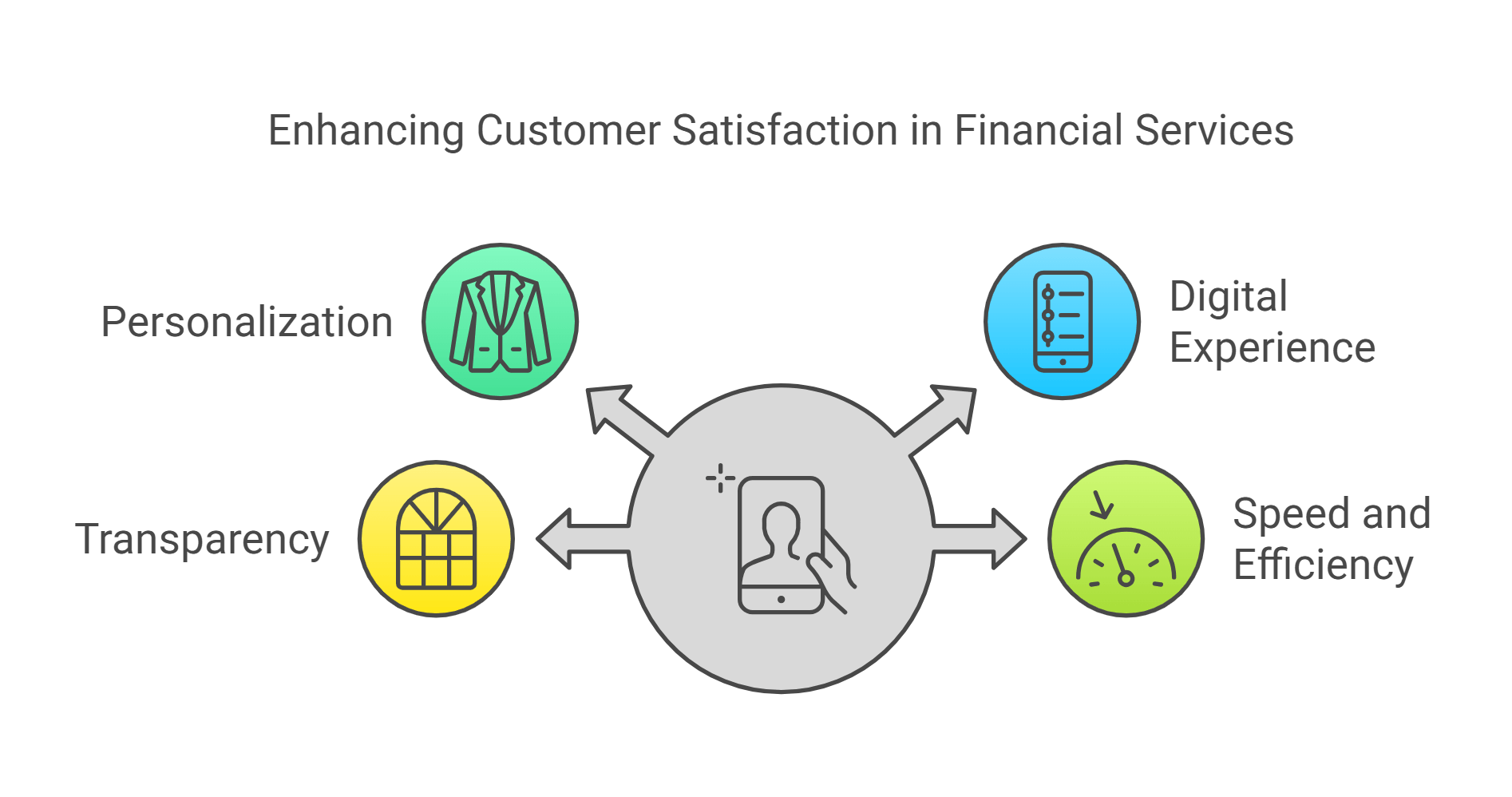Financial Services Customer Satisfaction

Building Loyalty in a Competitive Market
As the CEO of SIS International Research, I’ve spent decades helping businesses uncover what really drives their success. One of the most critical factors? Financial services customer satisfaction. It is the foundation of loyalty, retention, and long-term growth. That’s why we need to understand its importance in today’s real business world.
Why Financial Services Customer Satisfaction Matters
How do you feel when you have an exceptional customer experience? Likely valued, heard, and willing to return. That’s the power of financial services customer satisfaction. For financial institutions, it’s about more than just resolving issues. It’s about building trust, creating memorable interactions, and providing seamless experiences.
For example, we recently worked with a multinational bank to identify why its Net Promoter Score (NPS) was declining. Through detailed research, we discovered a key pain point: 63% of customers found the loan application process overly complicated. Simplifying it not only improved their satisfaction but also increased loan approvals by 25% within six months.
The Cost of Ignoring Customer Satisfaction

Unhappy customers don’t just leave—they talk. Studies show that dissatisfied clients share their experiences with an average of 15 others. In the financial world, where trust is paramount, that’s devastating.
On the flip side, satisfied customers:
- Are five times more likely to repurchase services.
- Have a 77% higher retention rate.
- Generate referrals, becoming your best marketers.
These numbers highlight why financial services customer satisfaction must be prioritized.
Key Drivers of Financial Services Customer Satisfaction
Bei SIS, we’ve pinpointed the critical factors influencing satisfaction in the financial sector:

1. Personalization
Customers expect tailored services that reflect their unique needs. In one study we conducted, 77% of respondents said personalized financial advice increased their satisfaction.
For instance, we worked with a wealth management firm implementing AI-driven tools to offer customized investment recommendations. The result? A 30% increase in client retention within a year.
2. Digital Experience
From mobile banking apps to online loan approvals, customers demand seamless digital solutions. Yet, many financial institutions underestimate how frustrating poor interfaces can be. Through our research, we’ve seen that even small usability improvements—like simplifying navigation—can boost satisfaction by 15%.
3. Transparency
Trust is the currency of financial services. Hidden fees, unclear terms, and poor communication erode confidence. Companies that prioritize clear, honest communication build stronger relationships.
4. Speed and Efficiency
No one likes waiting, especially when it comes to their finances. Timely service is crucial. In our research, 80% of respondents cited speed as a top driver of satisfaction.
Strategies to Improve Financial Services Customer Satisfaction

Improving financial services customer satisfaction doesn’t happen overnight, but it’s achievable with the right strategies:
- Listen to Your Customers: Regular feedback loops, such as surveys and focus groups, are invaluable. At SIS, we’ve helped countless clients implement Voice of the Customer (VoC) programs to significant effect.
- Leverage Technology: AI and machine learning can transform customer service by predicting needs, automating tasks, and delivering personalized solutions.
- Train Your Teams: Frontline employees often define customer experiences. Equip them with the tools and training to deliver exceptional service.
- Monitor Metrics: Metrics like NPS, Customer Effort Score (CES), and Customer Satisfaction Score (CSAT) provide actionable insights. They’re like a dashboard for your customer satisfaction efforts.
Case Study: A Success Story in Financial Services Customer Satisfaction
Allow me to share one of my favorite examples. A mid-sized bank in South America came to us with a challenge: customer churn was climbing, and their reputation was slipping. After conducting thorough research, we identified two main issues:
- Customers felt disconnected due to generic, impersonal interactions.
- The bank’s mobile app was clunky and outdated.
Our team recommended a two-pronged approach:
- Implement AI chatbots for 24/7 personalized support.
- Redesign the app for a more intuitive user experience.
Within a year, the bank saw:
- A 35% decrease in churn.
- A 40% increase in mobile app usage.
- NPS jumping by 15 points.
The Future of Financial Services Customer Satisfaction

The value of financial services customer satisfaction will only grow… But let’s not forget the human element. Behind every transaction is a person seeking understanding and trust. At SIS, we believe the future of customer satisfaction lies in blending cutting-edge technology with genuine human connection.
Here’s what’s coming next in the evolving landscape of customer satisfaction:
1. Hyper-Personalization Will Set the Standard
With AI and big data, financial institutions can deliver hyper-personalized experiences, from customized investment advice to real-time account notifications. Those who excel here will build loyalty that competitors can’t touch.
2. Seamless Omnichannel Experiences Will Be Expected
Customers will demand the ability to switch between channels—mobile apps, websites, call centers, and in-person branches—without missing a beat. A unified, seamless experience will no longer be a luxury—it will be a baseline requirement.
3. Predictive Analytics Will Anticipate Customer Needs
Why wait for customers to ask for help when you can anticipate their needs? Predictive analytics will empower financial institutions to proactively offer solutions, like alerting customers to investment opportunities or helping them avoid overdraft fees before they happen.
4. Real-Time Service Will Be Non-Negotiable
Gone are the days of waiting hours—or even minutes—for support. Instantaneous service through chatbots, AI assistants, and 24/7 digital platforms will become the standard. If your institution isn’t ready to deliver answers in real time, you’ll lose customers to those who can.
5. Building Emotional Connections Will Drive Loyalty
Financial institutions that make customers feel valued and understood—through empathetic communication and genuine care—will create deep, lasting relationships.
6. Transparency Will Become the Cornerstone of Trust
Customers want to know exactly where their money is going, how fees are calculated, and what risks they’re taking. Transparent communication will no longer just build trust—it will be the foundation of customer retention.
7. Security Will Remain Paramount
As digital services expand, so do cyber threats. The institutions that stay ahead of the curve in cybersecurity—offering robust protection and reassuring customers their data is safe—will win the confidence battle.
Final Thoughts
To succeed in the financial industry, you need more than great products. You need loyal customers who feel valued at every touchpoint. That’s where financial services customer satisfaction makes all the difference.
If you’re ready to take your customer satisfaction to the next level, let’s talk. At SIS International Research, we’ve spent decades helping financial institutions thrive in a competitive world. Reach out to us today—your customers deserve it.
FAQs
Q: What is financial services customer satisfaction?
Financial services customer satisfaction measures how well financial institutions meet or exceed customer expectations. It encompasses elements like personalized service, transparent communication, and efficient problem resolution.
Q: Why is customer satisfaction important in financial services?
Customer satisfaction fosters trust and loyalty. Satisfied customers are more likely to remain loyal, recommend services to others, and increase their lifetime value to the business.
Q: How can financial institutions improve customer satisfaction?
Financial institutions can improve satisfaction by leveraging technology, offering personalized services, training staff effectively, and consistently gathering and acting on customer feedback.
Q: What role does technology play in customer satisfaction?
Technology enables faster service delivery, personalized interactions, and seamless digital experiences. Tools like AI-driven chatbots and mobile banking apps enhance convenience and satisfaction.
Q: How does customer satisfaction impact business growth?
Satisfied customers drive retention, generate referrals, and boost profitability. Studies show that businesses with high customer satisfaction outperform competitors in revenue growth and market share.
Unser Standort in New York
11 E 22nd Street, Floor 2, New York, NY 10010 T: +1(212) 505-6805
Über SIS International
SIS International bietet quantitative, qualitative und strategische Forschung an. Wir liefern Daten, Tools, Strategien, Berichte und Erkenntnisse zur Entscheidungsfindung. Wir führen auch Interviews, Umfragen, Fokusgruppen und andere Methoden und Ansätze der Marktforschung durch. Kontakt für Ihr nächstes Marktforschungsprojekt.


